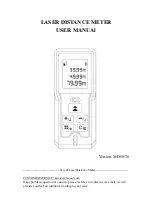
SV 104IS USER’S MANUAL ______________________________________________________
12
1.5
Measurement procedures
Preferably, when taking measurements, the noise dosimeter should be attached to the employee at
the start of a shift and collected at the end of the whole shift. In case a shorter period is sampled then care
should be taken to ensure that the result is representative of the full shift exposure. Shorter sampled periods
require that the sampler has a deep and full understanding of the expected working tasks during the shift and
the duration cycles of those tasks.
Before performing any noise measurements, ensure that employees selected for evaluation are
operating equipment or performing tasks under normal (representative) conditions, and emphasise
the importance of continuing to work in their usual manner (wearing the dosimeter should not interfere with
normal duties). Explain the purpose and procedures of sampling to the employee who will be wearing
the dosimeter and the importance of not touching, tapping or interfering with the microphone. Instruct
the employee not to remove the dosimeter unless absolutely necessary.
The general procedure for taking measurements could be as follows:
1.
Check that the indicated instrument battery life is at least twice the time required for
the measuring period
2.
Check the instrument setup mode is appropriate and change if necessary
3.
Check the calibration of the instrument and adjust the settings if required
4.
Secure the instrument onto the shoulder of the employee selected for sampling. Refer to
the chapter with specific requirements regarding orientation of the microphone
5.
Start the recording session manually if it is not programmed for an automatic timed start
6.
At the end of the measurement period, stop the recording session, and remove the dosimeter
from the employee
7.
Recheck the dosimeter’s calibration. If the instrument is not within the calibration limits then
the results are invalid (usually if a discrepancy is found between two successive checks of
more than ±0.5dB in the reference level, then the results of the measurements taken between
the two checks should be considered invalid and the cause investigated and the measurement
repeated).
8.
Follow your organisation
’s specific procedure for personal noise exposure recordings analysis
9.
Ensure the report is submitted to the appropriate person
10. Distribute copies of noise exposure recordings to test participants, explain the results and
ensure that their hearing protection adequately protects against the recorded noise exposure
levels.













































